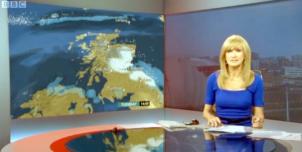Full Freeview on the Black Hill (North Lanarkshire, Scotland) transmitter
| Google Streetview | Google map | Bing map | Google Earth | 55.861,-3.874 or 55°51'40"N 3°52'27"W | ML7 4NZ |
The symbol shows the location of the Black Hill (North Lanarkshire, Scotland) transmitter which serves 940,000 homes. The bright green areas shown where the signal from this transmitter is strong, dark green areas are poorer signals. Those parts shown in yellow may have interference on the same frequency from other masts.
This transmitter has no current reported problems
The BBC and Digital UK report there are no faults or engineering work on the Black Hill (North Lanarkshire, Scotland) transmitter._______
Digital television services are broadcast on a multiplexes (or Mux) where many stations occupy a single broadcast frequency, as shown below.
64QAM 8K 3/4 27.1Mb/s DVB-T MPEG2
DTG-12 QSPK 8K 3/4 8.0Mb/s DVB-T MPEG2
H/V: aerial position (horizontal or vertical)
Which Freeview channels does the Black Hill transmitter broadcast?
If you have any kind of Freeview fault, follow this Freeview reset procedure first.Digital television services are broadcast on a multiplexes (or Mux) where many stations occupy a single broadcast frequency, as shown below.
64QAM 8K 3/4 27.1Mb/s DVB-T MPEG2
DTG-12 QSPK 8K 3/4 8.0Mb/s DVB-T MPEG2
H/V: aerial position (horizontal or vertical)
Which BBC and ITV regional news can I watch from the Black Hill transmitter?

BBC Reporting Scotland 2.4m homes 9.2%
from Glasgow G51 1DA, 26km west (271°)
to BBC Scotland region - 230 masts.

STV News 1.3m homes 4.8%
from Glasgow G51 1PQ, 26km west (271°)
to STV Central (Glasgow) region - 94 masts.
Are there any self-help relays?
| Ardtornish A | Transposer | 22 km NW Oban | 15 homes |
| Balquhidder | Transposer | 12 km NW Callander | 42 homes |
| Benmore B | Active deflector | 50 m WNW Glasgow | 7 homes |
| Blair Drummond | Transposer | 5 homes caravan park | |
| Blyth Bridge | Active deflector | 30 km SW Edinburgh | 50 homes |
| Glendaruel | Active deflector | 40 hotel | 40 homes hotel |
| Glendaruel B | Active deflector | 12 homes (second level) |
How will the Black Hill (North Lanarkshire, Scotland) transmission frequencies change over time?
| 1957-80s | 1984-97 | 1997-98 | 1998-2011 | 2011-13 | 3 Oct 2018 | ||||
| VHF | B E T | B E T | B E T | E T | W T | ||||
| C10 | ITVwaves | ||||||||
| C30 | _local | ||||||||
| C32 | com7 | ||||||||
| C35 | com8 | ||||||||
| C37 | C5waves | C5waves | |||||||
| C40 | BBC1waves | BBC1waves | BBC1waves | BBCB | BBCB | ||||
| C41 | +SDN | SDN | |||||||
| C43 | ITVwaves | ITVwaves | ITVwaves | D3+4 | D3+4 | ||||
| C44 | ArqA | ArqA | |||||||
| C46 | BBC2waves | BBC2waves | BBC2waves | BBCA | BBCA | ||||
| C47 | ArqB | ArqB | |||||||
| C50tv_off | C4waves | C4waves | C4waves | ||||||
| C51tv_off | LG | ||||||||
| C55tv_off | com7tv_off | ||||||||
| C56tv_off | _local | COM8tv_off |
tv_off Being removed from Freeview (for 5G use) after November 2020 / June 2022 - more
Table shows multiplexes names see this article;
green background for transmission frequencies
Notes: + and - denote 166kHz offset; aerial group are shown as A B C/D E K W T
waves denotes analogue; digital switchover was 8 Jun 11 and 22 Jun 11.
How do the old analogue and currrent digital signal levels compare?
| Analogue 1-5 | 500kW | |
| SDN, ARQA, ARQB, BBCA, D3+4, BBCB | (-7dB) 100kW | |
| com7 | (-10.7dB) 42.9kW | |
| com8 | (-11.1dB) 39.2kW | |
| Mux 1*, Mux 2*, Mux A*, Mux B*, Mux C*, Mux D* | (-14dB) 20kW | |
| LG | (-20dB) 5kW |
Local transmitter maps
Black Hill Freeview Black Hill DAB Black Hill TV region BBC Scotland STV Central (Glasgow micro region)Which companies have run the Channel 3 services in the Black Hill transmitter area
|
|
Thursday, 8 November 2018
R
Rupert5:39 PM
MikeP, thanks for your replies and for clearing up my misconception about interference when adjacent transmitters use the same frequencies. I had thought this was causing poor signal quality on COM7 and COM8 after the recent retunes.
A Freeview engineer said signal quality was fine but fitted a filter in the aerial lead to remove interference from 4g mobile transmitters. Seems fine now.
I'm still puzzled as to how moving COM7 and COM8 INTO the 700 MHz band is supposed to contribute to 700 Mhz CLEARANCE. Seems counterintuitive!
| link to this comment |
Friday, 9 November 2018
MikeP
11:38 AM
11:38 AM
Rupert:
After 2022, or thereabouts, they will not exist at all so will not be in the 700MHz band. 5G is not expected to be generally available until at least 2022 so those multiplexes will not cause any problems as they will be removed in time for the 5G service.
| link to this comment |
R
Rupert8:50 PM
Thanks again, MikeP, but I still don't see how moving COM7 and COM8 from the 500 MHz band into the 700 MHz band is a good idea, even if they will cease to exist in four years time. Why move them at all? What was wrong with leaving them well alone? Still, I suppose it provides employment security for Freeview's engineers!
| link to this comment |
Saturday, 10 November 2018
MikeP
12:19 PM
12:19 PM
Rupert:
The clearance of the 700 MHz band requires a large number of changes to the transmission scheme so that all the required transmissions could be fitted into the frequency spectrum remaining after the move out of the 700 MHz band. That all takes time so Arqiva started several months ago moving some channels to accommodate the reduction in spectrum available after 5G starts. To do that it was necessary to separate out some services into what are called Single Frequency Networks and that is why almost all of the COM7 and COM8 services are on channels 55 and 56 for now. Only 30 of the main transmitters carry those signals.
When it is deemed that most viewers have equipment that is capable of receiving and displaying the DVB-T2 transmission needed for HD services then there will be further work by Arqiva to bring the programme services that are currently on COM7 and COM8 onto the multiplexes that are below 700 MHz. That cannot be done as yet because too many viewers are unable to receive and display HD programmes due to limitations of their equipment (it is necessary to use equipment that is defined as Freeview HD and not 'HD ready' as that only means the screen can show HD but there is no HD decoder built in!). The DVB-T2 encoding is capable of carrying more data, so can be used to broadcast more channels within a multiplex than is possible with the current DVB-T encoding used for the SD multiplexes at present. That will mean fewer multiplexes will be needed and hence COM7 and COM8 will become redundant, so can be switched off to free up the 700 MHz band. So people can expect more changes over the coming three years or so and that's why most are recommending viewers use a wideband aerial that will be able to receive all the current and future transmissions. That aerial could be a conventional type based on the Yagi design of a log-periodic type, both types cover the whole of the allocated UHF frequency spectrum. That means there will not be any need to change the aerial in future.
Hope that clarifies a rather complex subject?
| link to this comment |
Monday, 12 November 2018
S
Scott9:11 PM
Why is a wideband aerial recommended? If the top part of the band is to be used for 5G would you not then be left with an aerial that is designed to pick up unwanted signals? I would have thought an aerial optimised for the lower channels would be better (provided 55 and 56 are still tolerable).
| link to this comment |
Tuesday, 13 November 2018
MikeP
9:48 AM
9:48 AM
Scott:
The usage of channels 55 and 56 is purely temporary on 30 of the main transmitters until sometime in 2022, when the programmes using the COM7 and COM8 multiplexes will be moved to other locations. 5G will not gain access to the 700 MHz+ band until it has been cleared of all TV broadcasts in 2022. Until then many viewers need a wideband aerial to get those two multiplexes as most non-wideband aerials designed for Group A or Group B are very poor at receiving 'out of band' signals at higher frequencies. If you never want to watch any of the programmes broadcast on COM7 or COM8 then you probably don't need a wideband aerial.
After the changes expected in 2022 the requiremnet will change so you will need an aerial that covers the frequencies between 470 MHz and 695 MHz (channels 21 to 49). The current design of wideband aerials will work perfectly adequately over that range but newer designs may appear will a lower top end cutoff frequency - but they are not suitable for use with the current channel allocation scheme.
| link to this comment |
Monday, 10 December 2018
S
steven harper3:36 PM
Edinburgh
ariel on roof .. can you keep me with transmitter updates please
| link to this comment |
steven's: mapS's Freeview map terrainS's terrain plot wavesS's frequency data S's Freeview Detailed Coverage
S
StevensOnln14:07 PM
steven harper: The only changes to have taken place at Black Hill are that COM7 & COM8 have moved to UHF channels 55 & 56 and the local mux has moved to UHF channel 30. There are no further changes planned according to Digital UK.
| link to this comment |
Saturday, 22 December 2018
Lost all channels on COM8
Forces tv will be sadly missed no Starsky and Hutch what am i going to do lol
| link to this comment |
Gary's: mapG's Freeview map terrainG's terrain plot wavesG's frequency data G's Freeview Detailed Coverage
Newton Mearns - Blackhill transmitter
All channels on COM8 gone since October
Also strangely at the same tme both my LG tv's show no aerial icon on the main menu
Presumably these tv's drop the icon when the power is not enough
Funny though when the aerial is plugged into the youview dn370 and 372t the signal strength on ch4 is 100% and quality around 82%
LG TV Issue perhaps?
Seen a lot of people mention it in the forums suspecting a damaged I/O board but it isnt its a single issue - happened around same time as i lost COM8.
Switching to my motorised satellite dish for freesat now - freeview is just too unreliable now!
| link to this comment |
Gary's: mapG's Freeview map terrainG's terrain plot wavesG's frequency data G's Freeview Detailed Coverage
Select more comments
Your comment please





